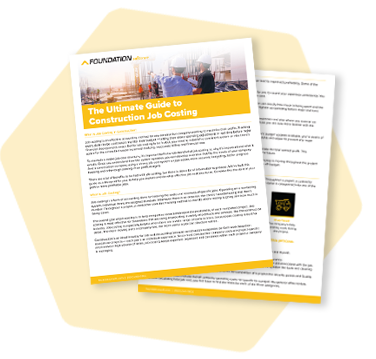
In construction and accounting, we sometimes throw around a lot of words, acronyms and alphabet soup. Find out what we’ve been talking about the whole time as you jump around on our Definitive Construction Accounting Glossary, and zoom in on related articles to learn even more.
A
Accounting equation states that assets = liabilities + equity. Because it forms the basis of the balance sheet, it’s sometimes called the “balance sheet equation” as well as the “basic accounting equation” and is a cornerstone of double-entry bookkeeping.
Accounts payable (A/P) are amounts owed and anticipated for payment under the accrual accounting method in construction. They accumulate and are “held” in a separate general ledger account.
Accounts receivable (A/R) are amounts earned and anticipated for collection under the accrual accounting method in construction.
Accrual accounting is a method of revenue recognition in which a contractor records income based on when it’s earned rather than when it’s collected. For example, as soon as an accrual-basis contractor issues an invoice for $1,000 of completed work, they can record $1,000 of revenue. Similarly, accrual-basis accounting recognizes expenses when they’re owed even before they’re actually paid. To “accrue” means to accumulate or add up over time. So the promise of earned revenue is generally “held” in a receivables account until the actual cash is collected. Read more »

AIA billing is a specialized progress billing format named after the American Institute of Architects (AIA). Contractors who perform this billing method often use the AIA Document G702 Application and Certificate for Payment cover sheet and G703 Continuation Sheet schedule of values, or they may use similar AIA-type forms. Read more »
ASC 606, Revenue from Contracts with Customers, is the newest set of accounting standards for recognizing revenue in construction accounting and other industries. ASC 606 introduces a “five-step model” to determine when and how to record income based on the delivery of performance obligations under contract. Read more »
Assets are most simply what a construction business has. They’re resources that hold value for a construction business because they can lead to cash. Types can include current assets, fixed assets and other long-term assets.
B
Backlog is the revenue a contractor still expects to earn on a construction contract before completing the project.
Balance sheet, or “statement of financial position,” is a financial statement that presents a snapshot of all the assets (values owned), liabilities (values owed) and equity (values invested) at any one point in time.
Billings in excess of costs is a financial accounting of project billings that are greater than the actual revenue earned from work performed on the job. This occurs when a contractor invoices for work they haven’t yet completed and is also known as overbillings. To help offset an inflated picture of revenue from overbilling, billings in excess of costs are recorded on a company balance sheet as a liability until the work for those billings are complete.
C
Capitalize is to record a purchase on the balance sheet as an asset rather than on the income statement as an expense. This allows construction companies to recognize the expense of an asset gradually as it’s used over its useful or depreciable life.
Cash accounting is a method of revenue recognition in which a contractor records income based on when they actually receive payment. Similarly, expenses are recorded when they actually make a payment. Cash accounting is primarily distinguished from accrual accounting. Read more »
Cash flows statement is a financial statement that shows how changes in a contractor’s operation, finance and investment activities are impacting their cash accounts. A statement of cash flows generally indicates a construction business’ short-term viability and ability to pay bills. Read more »
Certified payroll refers to construction payroll reporting that a contractor will submit, along with a signed statement of compliance, to a federal, state or local agency for each government contract worked. Certified payroll is often synonymous with prevailing wage payroll since it certifies that a contractor has appropriately paid the laborers on a project no less than the required “prevailing” wages. The most common type of certified payroll report is the U.S. Department of Labor’s Form WH-347.
Chart of accounts is the complete and organized list of a contractor’s general ledger accounts, which are each of the unique transaction records used to track amounts within the accounting system.
Completed contract is a method of revenue recognition in which a contractor records income and expenses only once they have finished the project. Like PCM, completed contract is a type of accrual accounting and has several unique advantages. However, the IRS poses several restrictions on when companies can use the completed contract method.
Costs in excess of billings is a financial accounting of revenue earned from work performed that’s greater than the amount billed so far. This occurs when a contractor doesn’t invoice for all of the work they’ve completed and is also known as underbillings. To help offset a low revenue figure on financial statements caused by underbilling, costs in excess of billings are recorded on a company balance sheet as an asset until the contractor can record that revenue earned.
Credit in construction accounting is a type of bookkeeping transaction entry that increases liability, equity and revenue accounts (“credit accounts”) and decreases expense and asset accounts (“debit accounts”). In double-entry bookkeeping, credits are balanced out by debits.
Current assets are assets that can be easily converted cash within 12 months. The clearest example is the money in a checking account. Other current assets can include money market accounts, certificates of deposit, salable inventory, accounts receivable and retainage receivable, expected refunds, prepaid expenses and underbillings.
Current liabilities are obligations that need to be paid within 12 months. Examples can include accounts payable and retainage payable, accrued liabilities such as payroll taxes, credit used, current portions of long-term debt, and overbillings.
Current ratio measures a contractor’s abillity to pay for their current liabilities with their current assets. It’s calculated as current assets / current liabilities. A lower current ratio, where current liabilities exceed current assets, can cause credit difficulties. A high current ratio can signal inefficient use of working capital if it means that cash is sitting in a bank earning low interest rather than being invested at a more advantageous rate. An alternative is the quick ratio. Read more »
D
Davis-Bacon generally refers both to the federal Davis-Bacon Act of 1931 and to the construction prevailing wage payroll requirements that follow from this and similar legislation. Read more »
Debit in construction accounting is a type of bookkeeping transaction entry that increases asset and expense accounts (“debit accounts”) and decreases liability, equity and revenue accounts (“credit accounts”). In double-entry bookkeeping, debits are balanced out by credits.
Deduction is an amount an employer takes out of an employee’s earnings and pays on their behalf for employee obligations. Examples include taxes, union dues, garnishments and fringe benefit accounts. Read more »
Depreciation is both (1) the natural loss of value over time and (2) the spreading out of an asset‘s cost over its life. Long-term assets depreciate as they age, receiving wear and tear. But unlike the loss of market value, which can fluctuate, depreciation is gradual and carefully calculated based on a pre-determined depreciable life. Depreciation also ensures that a major expense like new warehouse doesn’t weigh entirely on a single income statement. Instead, it spreads the expense out gradually over numerous income statements for the time in which it’s used.
Depreciable life or “useful life” is the time over which a long-term asset is expected to hold value for purposes of depreciation.
Direct costs are project expenses that, unlike indirect costs, contractors can clearly associate with a single construction job that’s responsible for incurring them. Direct costs increase or decrease only based on a single project’s activity. Examples include hourly skilled labor, building materials and subcontracts.
Double-entry accounting or “double-sided accounting” is a method of bookkeeping that records every transaction to two offsetting general ledger accounts. Each transaction must have one debit and one credit in the exact same amount. This two-sided method helps ensure the accuracy of construction bookkeeping by requiring that a contractor’s debits and credits always “balance” or “tie out.” The alternative is known as single-entry accounting.
E
Enterprise resource planning (ERP) often refers to a large software package or suite of applications that integrate multiple core business processes, such as accounting, human resources, compliance, production and customer management, among others. ERP systems are also sometimes known as “all-in-one” solutions in distinction to “best-of-breed” software used in combination with each other.
Equity on a balance sheet is what the owners of a construction company have invested in the business. It may be called “shareholders equity” or “owner’s equity,” depending on who owns the company. Examples can include capital stock, retained earnings from previous financial periods, and net income for the current period. Along with liabilities (what a business owes), the equity shown on a balance sheet represents how a contractor finances its assets (what they have).
Equity turnover ratio indicates how a contractor uses its equity to produce sales, using the formula sales / equity. Read more »
F
Financial statements are the official record of a construction company’s financial activities and position. They can include the income statement (or P&L), balance sheet and statement of cash flows.
Fixed assets are assets that (1) are tangible rather than abstract, meaning you can touch and feel them and (2) have a fixed life of usually three months or more, meaning they won’t suddenly lose all value. They represent a stable portion of a construction business’ worth, even though they do depreciate over time. Examples include vehicles, construction equipment and buildings.
G
General and administrative costs (G&A) in construction are generally the costs of running a business apart from any revenue-generating construction activities on jobsites, making them distinct from direct or indirect costs. Therefore, G&A will tend to be relatively stable or fixed even as construction activities increase or decrease over time. Examples can include office rent and utilities, administrative salaries and advertising.
Generally Accepted Accounting Principles (GAAP) is the set of standards and procedures that accountants use to record transactions and prepare financial statements. GAAP combines authoritative standards set by policy boards along with commonly accepted practices.
General ledger (G/L) is the primary, authoritative record of a construction company’s financial transactions. The G/L is made up of various accounts that each track and “hold” particular values as an amount called a balance. Examples of accounts include commercial revenue, direct labor expenses, accounts receivable and accrued payroll taxes.
I
Income statement or “profit-and-loss” (P&L) is a financial statement that shows how a construction company’s total revenue and expenses add up to either a profit or loss of profits for a given period of time. Generally, a series of income statements will indicate which direction a contractor is trending in and how fast they’re getting there. A simple P&L follows the basic formula of income – expenses = profit (or loss).
Indirect costs are generally job costs that relate to construction activities but, unlike direct costs, for which no single job is directly responsible. Indirect costs will typically increase whenever overall construction activities increase. An example might include maintenance costs for a dozer used on numerous jobsites.
J
Job cost structure is the outline of construction activities and cost types that a contractor uses to organize and record their job costing consistently across all projects. A job cost structure may also include project phases among additional levels of organization.
Job costing is the practice in construction accounting of tracking costs to particular projects and job activities according to a job cost structure. While a contractor records company financial transactions in the general ledger, job costing records project-based transactions in a separate component of the construction accounting system, which allows both the general ledger and job costing sides to match. Read more »
L
Leverage is a contractor’s proportion of debt to equity. In other words, leverage compares how much creditors have invested in a construction company (debt) with how much ownership has invested (equity). A higher leverage ratio generally indicates greater risk.
Liabilities are most simply what a construction business owes. From the perspective of a balance sheet and the accounting equation, it’s how a contractor finances its assets (what they have). Types of liabilities can include current liabilities and long-term liabilities.
Lien waiver is a document that certifies that the contractor, subcontractor or vendor has received a certain amount in payment and therefore gives up any potential claim on that much of the property’s value. For example, if a subcontractor receives $50,000 for their work on a job, they might issue a lien waiver that says they won’t dispute $50,000 worth of the value they added to that property. Lien waivers can be either conditional or unconditional and be used for either progress or final payment.
Long-term assets (or noncurrent assets) other than fixed assets are resources that a construction business has but that wouldn’t be available as cash in less than 12 months. They can include assets held for investment like land or stock, long-term deposits like leases, or intangible assets like trademarks or customer lists.
Long-term liabilities (or noncurrent liabilities) are liabilities or obligations that a construction business isn’t expected to pay within 12 months. Examples can include the principal on long-term debts like loans or capital leases.
M
Matching principle is a basic guideline of accounting that states that a company must report an expense on its income statement in the same financial period that it records revenues that are related to that expense.
Mechanic’s lien or “construction lien” is a claim on a property filed by a contractor, subcontractor or supplier who added to its value through labor or materials but who has not yet been paid. Once a party receives payment, they can cancel the mechanic’s lien, or if they haven’t filed a lien, they might issue a lien waiver in order to waive any potential lien rights.
N
Net D is a common form of construction payment terms, under which the invoiced party has a specified number of days (“D”) to pay the full (“net”) amount. For example, under “net 30” payment terms, a customer has 30 days after invoicing to pay the full amount with no discounts offered. If a vendor does offer a discount to incentivize customers to pay earlier, such as 2.5% off when paid within 10 days, it may be expressed as “2.5/10 net 30.”
O
Overbillings occur when a contractor bills ahead of work completed as identified on the WIP schedule or over/under billings report. For example, if a contractor has billed 60% of a job’s estimated revenue but calculates it as only halfway through its estimated costs, it’s overbilled. Construction CPAs and sureties generally see some amount of overbilling as positive. Overbilling keeps contractors ahead of their cash flow; however, overbilling is essentially borrowing on future work that still has to be completed. Too much overbilling will eventually catch up with a contractor. Read more »
Overhead allocation is the practice in construction accounting of recognizing costs that are the responsibility of multiple jobs and spreading them across multiple jobs proportionally. Contractors can use numerous overhead allocation methods. Read more »
Overhead is typically a broad category of costs that aren’t caused by any single construction project (direct costs). In this view, there are two kinds of overhead: indirect costs and general and administrative costs (G&A).
P
Percentage-of-completion (PCM) is a method of revenue recognition in which a contractor records income based on how much of the project they’ve completed. Because PCM is an accrual method, income is recognized when the contractor bills rather than when they’ve received payment. Construction CPAs can advise contractors on a number of different PCM methods to determine how much of the project “counts” as complete. These include cost-to-cost methods, physical completion methods and labor methods. The IRS requires contractors whose revenue exceeds a certain annual average or whose contracts are a certain length to use this method for tax purposes.
Performance obligation under the ASC 606 revenue recognition standards is a promise in a contract with a customer to transfer to them either: (a) a good or service (or a bundle of goods or services) that is distinct or (b) a series of distinct goods or services that are substantially the same and have the same pattern of transfer to the customer. Read more »
Prevailing wage is the rate of compensation that “prevails,” or represents the standard, for each class or trade of construction laborer on a similar job in the same area. Government agencies determine the prevailing wages within their jurisdiction for public-works projects and require contracted construction companies to certify their compliance using certified payroll reports.
Profit fade is the gradual loss of gross profit on a construction project. When profit fade occurs, the project at one point appeared to have a greater promise of profitability, but an increase in unexpected or unaccounted costs or production may begin to exceed billings.
Progress billing occurs when contractors bill based on how much of the project is completed at each interval. For example, if a company’s completed 25% of a contract, their total invoices to the customer would equal 25% of the contract value. A simple progress billing formula is percentage complete * (contract amount + approved change orders) = amount billed.
Q
Quick ratio measures a contractor’s ability to pay for their current liabilities without having to convert non-cash assets to cash. It’s calculated as (cash + receivables) / current liabilities. Therefore, unlike the current ratio, the quick ratio factors out certain assets like prepaids, inventory and underbillings. A contractor with a lower quick ratio may not be able to cover their obligations without having to sell inventory. A high quick ratio can indicate inefficient use of cash. Read more »
R
Receivables turnover ratio indicates how effectively a contractor collects on the credit it extends, using the formula net annual credit sales / average accounts receivable for a given period. As a result, this ratio is equal to the number of times that the construction business collects its average A/R. Read more »
Request for change order (RFC) is a project document that a contractor may submit to an owner or designer in order to request a change to the scope of work, schedule or monetary value of a construction contract.
Request for information (RFI) is a project document that formally records a contractor’s questions about the design or specifications under a particular construction contract. RFIs are often used during the bidding and construction phases of the project cycle to gain additional clarification, resolve any discrepancies and prevent costly corrections later.
Request for proposal (RFP) is a project document that an owner may use to solicit bids from contractors on a project by detailing the scope of work, contract terms and bidding process. In response to the RFP, a contractor would submit a proposal of how they would execute the job and how much they would charge. “RFP” can also be an abbreviation in construction for “request for pricing.”
Retainage is the predetermined amount of money that an owner may withhold from payment until they’re satisfied with the completion of a contract. Contractors often track retainage in a dedicated G/L account separate from other accounts receivable until it becomes billable. Retainage is most often a percentage of the total revised contract value, including approved change orders. Read more »
Revenue recognition or “income recognition” refers to the consistent rules a contractor uses to determine when they’ve officially made money on a project. The main methods of construction revenue recognition traditionally include cash-basis, completed contract and percentage-of-completion but currently fall under the new guidance of ASC 606. Read more »
S
Schedule of values (SOV) is a line-item list of each task or component of a particular project, along with its description, quantities and cost, that add up to the total price of a construction contract.
Section 179 refers to an IRS tax rule that allows businesses, including construction contractors, to subtract the purchase cost of qualifying equipment and software from their taxable income in the same year they were bought. The Section 179 deduction does have a limit on the amount that can be deducted; however, a “bonus depreciation deduction” may be applied to amounts above that limit. Read more »
Single-entry accounting is a method of bookkeeping used by some small construction businesses and in personal finances. Each transaction is recorded as a single item adding to or subtracting from a total account balance. Single-entry accounting is distinguished from double-entry accounting.
Software as a service (SaaS) is a model of making software available to users online by hosting it on vendor-owned or third-party servers, rather than installing it only on particular computers. Because a user will access SaaS applications from the internet rather than their computer’s hard drive, it’s often referred to as “cloud” software or “cloud computing.”
Submittal is a project document that a contractor or subcontractor provides, typically to the design team, for approval in order to verify the correct materials and specifications. Submittals might include shop drawings, physical samples, technical data sheets and spec sheets.
Surety is a party, such as a bond agent, that assumes the risk and responsibility for a contractor’s performance on a construction project. A surety bond generally reduces the owner’s risk by helping ensure satisfactory contract completion and reduces a subcontractors’ risk by helping ensure payment.
T
Time-and-material billing bases the construction contract price on a per-hour labor rate plus the cost of materials used. The contractor may also include a standard markup. Read more »
Transmittal is a formal communication of project documents such as shop drawings and specifications that, unlike submittals, RFCs, RFIs, RFPs, etc., doesn’t require a response from the recipient. A transmittal document can also refer to the cover page of a submitted project document.
U
Underbillings occur when a contractor bills for less money than they’ve earned for work completed as calculated by the WIP schedule or over/under billings report. For example, if a contractor has only billed 40% of a job’s estimated revenue but has already encountered half of its estimated costs, the project is underbilled. Underbillings are generally considered by construction CPAs and sureties to be undesirable. Substantial or persistent underbilling can result in negative cash flow and indicate numerous other issues. These may include poor A/R management, inaccurate estimating or a large number of unapproved change orders. Read more »
Uninstalled materials under the ASC 606 revenue recognition guidance include materials that are (a) not distinct, (b) expected to transfer into customer control significantly before receiving related services, (c) significant in cost relative to the total expected costs for satisfying the performance obligation and (d) procured from a third-party without significant design or manufacturer on the part of the contractor.
Unit price billing uses a fixed price-per-unit rate with which to invoice a contractor’s customer. Read more »
Useful life see depreciable life.

W
WH-347 is a federal form published by the U.S. Department of Labor to report certified payroll compliance under government contracts.
WIP (work-in-progress or work-in-process) is a report designed to track the progress of active jobs, as well as their financial performance. In addition to looking at the percentage of completion and the cost to complete, it also determines whether a job is overbilled or underbilled relative to its progress. When using the percentage-of-completion method for revenue recognition, companies include a WIP schedule with their financial statements. Read more »
Working capital is the amount of money that a contractor has free and available to use for construction operating activities. It’s calculated as current assets – current liabilities.
Working capital turnover ratio indicates how a contractor uses its capital to produce sales, using the formula sales / working capital. A high ratio may indicate lack of sufficient capital to support sales growth, whereas too low of a ratio could suggest they’re putting working capital to work inefficiently. contractor with a lower quick ratio may not be able to cover their obligations without having to sell inventory. Read more »
Share Article
Keep on current news in the construction industry. Subscribe to free eNews!
Learn about our software more in depth with product overviews, demos, and much more!

Our ACA reporting & e-filing services include official 1094-C and 1095-C IRS reporting, optional e-filing (no applying for a TCC code required), mailing to your employees and experienced support to help you.

There are plenty of reasons to make FOUNDATION your choice for job cost accounting and construction management software — just ask our clients!

From job cost accounting software, to construction-specific payroll. Get an overview on your next all-in-one back-office solution.



